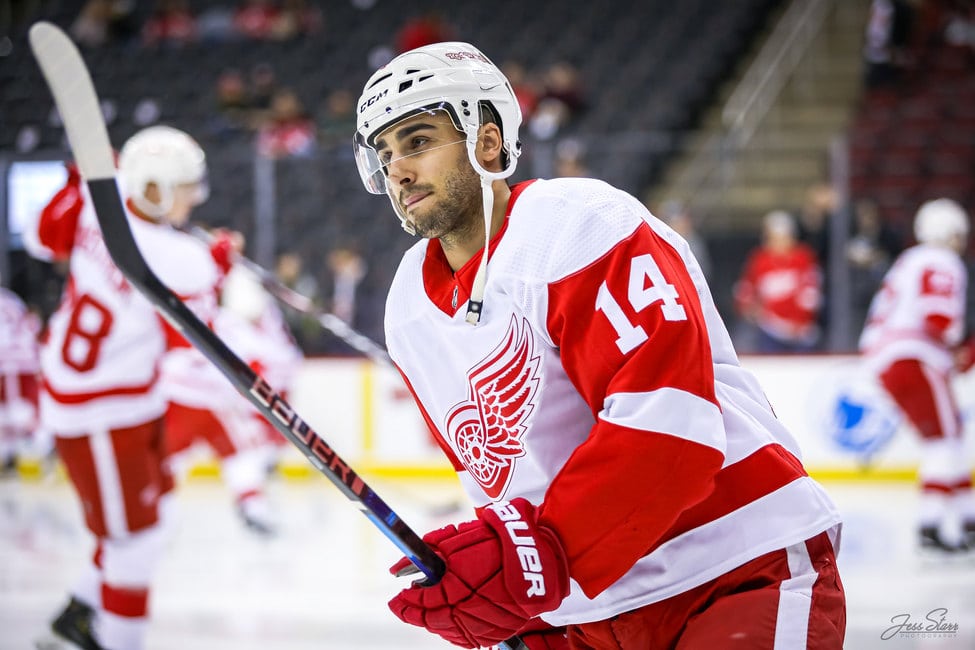As the 2024 NHL Playoffs progress, Steve Yzerman and the Detroit Red Wings remain hard at work preparing for the 2024-25 season. There’s plenty to do – re-sign key free agents, finalize the draft board, and touch base with other general managers on their plans.
In the meantime, I wanted to empty my notebook and discuss a few topics that have been top-of-mind lately. Let’s dive in.
Red Wings Face Tough Choice With Fabbri
Between Detroit’s lack of cap space and their desire to improve, Robby Fabbri presents quite a conundrum. A case can be made to move the forward. But then again, so can one for keeping Fabbri.
Starting with the status quo—keeping Fabbri in Detroit—his scoring ability is front and center. His 18 goals ranked sixth on the Red Wings last year, and his 0.095 average shot danger at five on five topped all Red Wings regulars.
Detroit needs more players who can create high-danger chances, not less.

In addition, Fabbri is entering a contract year, and this will likely be the last major payday of his career. It’s fair to say that he’ll be motivated in 2024-25.
On the other hand, moving his $4 million cap hit will open up a lot of space for Yzerman to work with. With Moritz Seider and Lucas Raymond in line for massive raises, the Red Wings need to create cap space somehow.
There’s also the question of his role. With the Red Wings likely employing a checking line once again next season, Fabbri would have to skate on either the second or fourth line, and the second might be too high for someone with limited defensive abilities.
Lastly, Fabbri’s offensive appeal makes him a desirable trade chip. And by that, I mean the Red Wings won’t have to offer up a sweetener to offload his cap hit.
Related: Ranking the Red Wings’ 2024 Offseason Priorities: Detroit’s Needs & Targets
The Red Wings don’t need to trade Fabbri. There are other ways to shed salary. But if they want to upgrade the top six and second defensive pair, then Fabbri and his cap hit might need to be sacrificed.
Grand Rapids-to-Detroit Pipeline
Back in 2013, the Grand Rapids Griffins defeated the Syracuse Crunch to win the AHL’s Calder Cup. The Griffins won it all again in 2017, and this year’s squad has the talent to go all the way as well.
There’s a lesson to be learned from the 2012-13 season – one that speaks to the 2023-24 Griffins. But it actually comes from the Crunch – Yzerman’s AHL team at the time.
That year, Yzerman purposely kept Tampa Bay’s top prospects together in the AHL to develop chemistry. Those players included Tyler Johnson, Ondrej Palat, Brett Connolly, Richard Panik, and Radko Gudas. It paid off – they reached the Calder Cup Final, then all but Connolly were promoted to the Lightning full-time for the 2013-14 season.
They grew together. They succeeded together. Then, they joined the Lightning together.
Sound familiar?
Detroit’s top prospects are following a similar path. Simon Edvinsson and Jonatan Berggren should have been with the Red Wings all season, but spent the majority of their campaigns with the Griffins. They’ll be in Detroit next year, along with Albert Johansson and possibly more – one or two of Marco Kasper, Elmer Soderblom, and Carter Mazur could make the jump as well.
Related: Red Wings Mock Draft 1.0: Detroit Picks 15th
Is it risky to have so many young players joining the NHL full-time all at once? Sure. But there’s also precedent for it succeeding under Yzerman’s watch.
After all, there’s more than one way for a prospect to develop into an NHL player.
Rising Salary Cap Could Impact Free Agency
Over the last five years, the NHL salary cap has only increased by $2 million – from $81.5 million in 2019 to $83.5 million today. That’s about to change.
The 2024-25 season will see the cap jump to $87.7 million, giving teams additional dollars to work with this offseason. It’s expected to increase once again for the 2025-26 campaign, with the latest estimates targeting $92 million.
We could see a significant jump beyond that, too. The current CBA is set to expire in September 2026. Given the NHL’s post-pandemic surge in popularity and revenue, plus a favorable TV contract, the salary cap could exceed $100 million for the 2026-27 season (or soon after).
On a recent episode of the 32 Thoughts podcast, NHL insider Elliotte Friedman wondered if these increases would impact contract negotiations today. Multi-year contracts are handed out like party favors during the offseason, after all. Shouldn’t players get a bigger slice if the pie is growing?
This is something to monitor when it comes to Seider and Raymond’s next contracts. Conventional wisdom suggests that long-term deals are the best option, but the rising salary cap adds complexity to the situation.
Related: Contract Projections: Moritz Seider | Lucas Raymond
The same could be said for star players hitting the free agent market this summer. Might players prefer one- or two-year deals knowing where the salary cap is heading and negotiate more down the road? With this in mind, it would be a worthwhile venture for Yzerman and company to conduct contingency planning to evaluate how to proceed with free agency if targets prefer short-term deals.
Data courtesy of Natural Stat Trick and CapFriendly.
